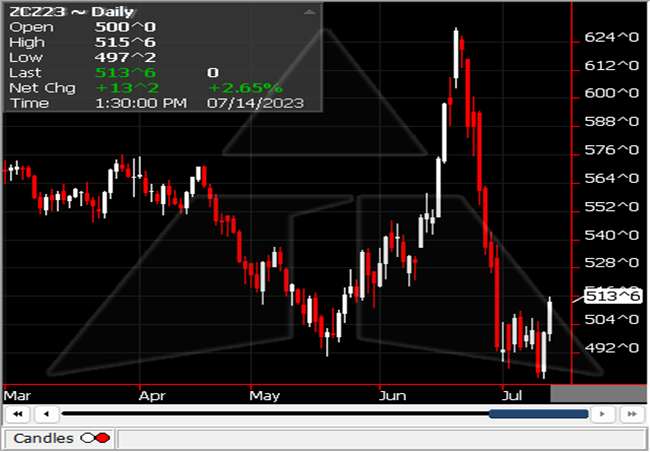
Following the high-priced marketing year of 2022, the commodity trading world was confident 2023 had all the ingredients to be extremely volatile. Historically tight domestic supplies of both corn and soybeans as well as a late winter in the Northwest U.S. put extreme pressure on farmers to plant timely this spring. Obviously, the “on-again, off-again” conflict between Russia and Ukraine continues to have profound impacts on the global export market.
There are the U.S. economic woes that seem to linger, making it difficult for traders to have confidence investing in anything. And there’s that one item farmers around the world deal with every time they choose to plant another year of crops – weather!
Unpredictable weather
It seems we all have such a love-hate relationship with Mother Nature. We want the weather to know what we need at the exact moment we need it, and then deliver it on our own personal schedule. We absolutely hate how a prolonged hot/dry period can rip the life out of so much hard work that goes into growing a crop! But we also love the way that can all change in an instant as the skies fill with moisture and drop what seems like buckets of hope just in the nick of time.
No one knew what the weather would do this growing season. Several of us (me included) were worried it felt eerily similar to the drought-stricken year of 2012. Every week’s drought map showed a bigger area that was being affected, and the weekly condition scores kept dropping.
As a result of this, Dec 23 futures rallied from $4.90 ¾ on 5/18 to $6.29 ¾ on June 21 with traders building a “weather premium” into the market. The biggest concern the trade had at the time was whether the corn crop could make it through the quickly approaching pollination period.
But even quicker than the weather rally had arrived, the extended forecast changed showing chances for widespread rain the first few days of July. With that, Dec 23 futures dropped $1.40+ in two weeks to $4.85 ½ on July 5. It was an unprecedented drop, leaving many of us shaking our heads wondering what had just happened.

Managing through a weather market
In my opinion, managing through a summer weather market is the toughest thing to do the entire year. There are so many emotions that get in the way of making good business decisions. You need tools that are flexible and protect – not predict.
Since I personally struggle when the heat ratchets up and the faucet turns off, I keep three simple questions in my mind so I don’t make a decision I’ll regret later:
Is my crop in serious trouble of a production problem?
How much do I have hedged or pre-sold to the elevator?
What is my break-even price at both my APH and crop insured levels?
The answer to the first one is up to every individual as they monitor their crop. Genetics have improved dramatically, so our crops can deal with much more stress than they used to. But if you think you have a problem, knowing what you have hedged or pre-sold is the next step.
Many of you have a spreadsheet or a program that you use to track your sales and positions throughout the year. If you do in fact have a crop problem, that tracking tool can be invaluable to you. Most of us rely on our personal experience to find comfort in future unknowns. For example, I remember raising 100 bushels per acre of corn in 2012 – so that’s a level I’m confident our farm can produce. Eventually though there comes a point where we don’t want any more sold, and that’s where your crop insurance comes in.
Crop insurance is key
By no means am I a crop insurance expert. But there are a few basics I keep in mind when developing a marketing plan to compliment my crop insurance. First, establish worst-case price scenarios using your coverage level. For example, if your APH is 220 bpa corn, you take 85% RP insurance, then your floor price if you raise your APH is $5.02/bu. Below this price, if you raise exactly your APH, then, in theory, your crop insurance revenue should kick in.
Next, establish your break-even price at your APH. For example, the University of Illinois FarmDoc production costs are estimated at around $1,200/ac for Central Illinois High Productivity Farmland in 2023. At 220 bpa production, your break-even price is $5.45/bu.
Finally, establish your worst-case breakeven price. You can do this by taking your crop-insured yield of 220 bpa x 85% giving you 187 bpa. Next, establish your break-even price based on your crop costs. Your $1,200/ac cost divided by your crop insured yield of 187 would give you your worst-case break-even price of $6.43/bu.
Eliminate worry with put options
What do you do with these levels once you have established them? It’s time to find a marketing tool that can protect yet allow for upside potential. The put option is the perfect tool for this scenario. In 2023, the market has allowed us to buy $5.50-$6.00 Dec 23 puts very economically (4-5% cost vs price protected). From the examples above, we have been able to buy puts protecting 2 of the 3 important levels. Once those puts are in place on 100% of your APH, then it honestly becomes a wait-and-see time period until harvest.
The put protects against lower prices but gives you the confidence to know that if prices rally you can still participate. There are two ways you can participate:
Rolling your puts higher and raising your floor level
Selling your crop at the higher market price
In either scenario, you are making sure to reward the rally. In weather markets, that’s the key to success in my opinion – take advantage of the rally when it occurs without putting yourself at higher risk. Weather rallies normally don’t last long. So be prepared and be decisive. You will be amazed at how well you do!
Contact Advance Trading at (800) 747-9021 or go to www.advance-trading.com.
Information provided may include opinions of the author and is subject to the following disclosures:
The risk of trading futures and options can be substantial. All information, publications, and material used and distributed by Advance Trading Inc. shall be construed as a solicitation. ATI does not maintain an independent research department as defined in CFTC Regulation 1.71. Information obtained from third-party sources is believed to be reliable, but its accuracy is not guaranteed by Advance Trading Inc. Past performance is not necessarily indicative of future results.
The opinions of the author are not necessarily those of Farm Futures or Farm Progress.
Read more about:
WeatherAbout the Author(s)
You May Also Like






